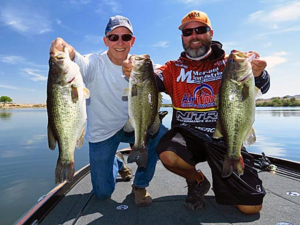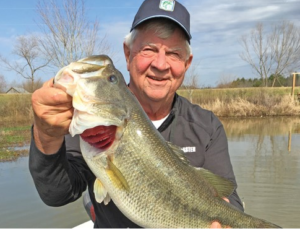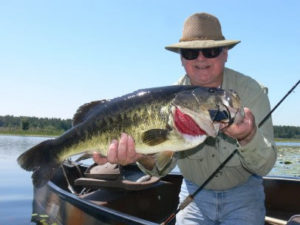Beginner’s Guide to Finding Fish
By M.L. Anderson
from The Fishing Wire

Found Fishi
The first step to catching fish is to find them, and this isn’t always easy. Some people just get out there and start throwing various lures in random spots until they get lucky. Some seem to keep going back to the same spots over and over. If they get skunked, they say that the fishing is bad that day. Still others simply watch what other people are doing and try to copy that, whether they actually see the other guy catch a fish or not. Apparently, they assume that EVERYONE on the water is smarter than they are. There are some who spend hours on the phone, pumping their buddies for information and trying to duplicate their results. And then there are the pros.
The real pros know that you have to find your own fish. “It’s really hard to catch someone else’s fish,” insists Gary Dobyns. “If you weren’t there to find them and figure out what it took to catch them, it’s almost impossible for someone else to send you to that spot and have you catch fish.” A pro like Dobyns, who is able to find and catch bass consistently, has learned the secrets to patterning bass. Bass are animals with certain needs and instincts. They all respond alike to biological stimulus. This is certainly to the advantage of a bass fisherman: learn how bass behave under certain conditions, and you’ll know where to look for them. Years ago, legendary bass angler Rick Clunn told me his three-step process for patterning bass, and since then many other excellent fishermen have told me how they do it.
RICK CLUNN STEP ONE: SEASONAL PATTERNS
Even before you get to the lake you should be able to eliminate quite a bit of water. Take a map of the lake and divide it into sections. The deepest, clearest parts can be section one, midrange depths are section two, and shallow coves and river inlets are section three. Clunn also divides coves into those same sections – deep, such as a channel, midrange like humps between feeder channels, and shallow – backs of coves, flats, etc. You can add a section four if there is a river or a creek you can run the boat up.
Where do you start? You can make general assumptions based on the time of year. Generally speaking, bass will be deeper in winter and summer, shallower in spring and fall. Not all the bass in the lake will deep at one time, of course, but seasonal patterns give you a general idea of where to start.
CURRENT PATTERN
Once you have a seasonal pattern established, pick an area to fish. You may want to focus on a single large cove, especially if it has a lot of different depths and structures. Fish that cove as though it were a pond. Identify what kinds of objects are in the area: channels, humps, vegetation, rock piles, rip rap, man-made structures like bridges, etc., and work every kind of object until you feel like you’ve really checked it out thoroughly. Use a couple of different baits. It will soon become clear which kinds of objects are holding fish, and you can stop wasting time on the stuff that isn’t holding fish right now.
There are actually two kinds of patterns you can find this way. An individual pattern is when a certain kind of object is holding bass – say you’ve fished everything in your cove and have only caught fish on submerged logs in five feet of water. Now you can leave and visit other areas of the lake and fish other submerged logs at around the same depth with a pretty good chance of catching more fish. A concentration pattern is usually something like an expanse of submerged brush or vegetation that has a whole school in it. If you find one of these, stay there. The individual pattern is the most common, and if you put a bunch of those similar spots together, it’s usually referred to as a “milk run”. Fishing stuff between the pattern is a waste of time, says Clunn. Just go from object to object as quickly as possible. One of these patterns can last days or just minutes. If it fails, start over and figure out what the new pattern is.
SPECIFIC PATTERN
According to Clunn, a small percentage of elite anglers will be able to get to step three, which is identifying a specific pattern. It is something that very good fishermen do subconsciously for the most part. For instance, say our submerged logs are the current pattern. You go from log to log and fish them all. An elite angler will soon know an even more specific pattern — he will know exactly where on the log the fish will be.
LURES FOR ESTABLISHING A PATTERN
The only reason to pick a lure is confidence. A lure is first of all for finding fish. Clunn’s top three lures for finding fish are spinnerbaits, crankbaits, and plastic worms or jigs. He usually starts with a spinnerbait or a crankbait – choose whichever one you can keep in the strike zone for longer. In warmer water the strike zone is bigger. In colder water it is smaller. He doesn’t worry too much about color. Fishermen think about color more than they do about sex, he says. Your confidence in your fishing is in total control of your success, so pick a lure you feel confident that you can fish well. Pick any color you want as long as you believe in it. He usually picks natural colors. If you don’t feel good about it, you won’t fish it well.
OVERNIGHT CHANGES
Things like a cold front, a storm, a rising barometer, or weekend pressure and traffic can change things overnight. Let the fish tell you what’s going on. Try the pattern you established the day before, and if it isn’t working, you have to change. Cold fronts will move the fish either deeper or tighter to cover. The strike zone shrinks. Maybe you need to flip those logs today instead of running a spinnerbait past them. Maybe you need to go just a little deeper to the next structure. Clunn says that if you’re a beginner you shouldn’t worry that you don’t have a lot of years in the boat. Some anglers pay more attention and get more out of a year than others do in a lifetime. The biggest thing is to pay attention. Keep a log that you can refer back to.
JOHN MURRAY’S METHOD
John Murray started out bass fishing as a kid in Arizona, and is still considered to be one of the best bass fishermen Arizona has ever produced. His advice? “Don’t discount any part of the lake” is Murray’s first rule. “Fish all over, starting shallow.” Narrow your focus to your strengths at first–use lures you are proficient with and have confidence in. When you first start fishing and don’t really have a lot of confidence in any one lure yet, Murray says to try fishing just one lure all day until you know how it reacts to different retrieves and speeds, and you are confident of at least your ability to cast the lure accurately and fish it properly. Every angler should be able to fish spinnerbaits, crankbaits, plastic worms, and jigs with confidence.
“First of all, look for how deep the shad are,” says Murray. “Wherever the shad are, that’s where the bass are.” He uses his electronics to find balls of shad and pinpoint their depth. (The first time I ever fished with Murray, he was using a flasher and a paper graph, and he was kicking butt back then.)
MURRAY’S FIVE KEY AREAS
Once he has determined the depth of the bait fish, choosing which of the five key areas to try first is easier. Points are first on the list, and can hold bass at any depth. Murray will make several different presentations on a point using different lures, favoring spinnerbaits and crankbaits. The key to fishing a spinnerbait is the retrieve, says Murray. He usually keeps the lure one or two feet off the bottom and works it slowly, concentrating on the feel of the blades turning. If the “thumping” stops, he sets the hook.
Second on the location list is backs of coves. Topwater lures and spinnerbaits are prime choices here, and Murray likes Ricos, Zara Spooks, buzzbaits, and jerkbaits for shallow fish. For fish with lockjaw, flipping a plastic worm or lizard can be a better method. For shallow fishing (less than ten feet), Murray says to use a couple of baits and keep casting. Cover lots of water and look for bites, especially if you’re pre-fishing. If you know the fish are shallow but you can’t get them to take a fast-moving lure, make sure you flip into a few bushes or rockpiles before you move on.
If the fish aren’t in the backs of the coves, the next area Murray will try is a windy bank. He’ll throw crankbaits and spinnerbaits up into the brush, or pitch a lizard or jig to shore, looking for active bass that are foraging for shad and crawdads whipped up by wind and waves.
Steep banks, walls, and cliffs are fourth on our list of bass holding locations. These structures hold fish at different depths at different times. A worm or a tube bait is usually Murray’s first lure choice for steep shorelines like this. Getting the boat close to the bank, he casts the lure parallel to the cliffs and bounces it down the wall, feeling and watching the line to see if it moves differently than it should or stops where it shouldn’t.
If he still hasn’t found fish, Murray moves out to location five: outside structure. These submerged islands, rockpiles, underwater ridges, etc., often hold large concentrations of quality fish, especially in heavily fished lakes. Many anglers ignore this structure either because they don’t know it’s there or they don’t know how to fish it. The best structure is the stuff that isn’t marked – no buoy on it, in other words.
The key to fishing deeper water, says Murray, is learning to use your electronics. Murray makes sure he has good depthfinders on the console as well as the bow. The depthfinder on the console is the one to watch while you’re idling around inspecting structure, and the one on the bow is the one you keep your eyes on while you fish. If you know how to interpret what you see, you can position yourself right over deep fish and present your lure to them effectively.
A good depthfinder is invaluable for locating and fishing these underwater treasure troves. In the old days, fishermen would take years to study a lake, actually using a weighted string to map underwater depths, but with modern graphs you can do it in a day, especially if you have a topo map of the lake to get you started. Again, Murray says to look for the depth of the baitfish, then look for submerged structure that intersects this depth. Any lure that you have confidence in and can fish at the proper depth can be used to probe this structure: Ned rigs, split-shot rigs, drop shots, jigs, spinnerbaits, or crankbaits can all be effective.
Even on a strange lake or in unusual conditions, thoroughly fishing the five key holding areas with a combination of baits chosen from the top basic lures will help you find fish. Once you’ve determined where the active bass are, concentrate on that type of location only–don’t waste time fishing backs of coves after you’ve already discovered that the fish are on points. Cover the area thoroughly with a variety of lures. You have to find fish to catch them, and following this system is a proven way to begin.
WHAT TO DO WHEN YOU DON’T KNOW WHAT TO DO
Pick a process: Clunn or Murray. Fish methodically and eliminate areas and structure until you start catching fish. Then pass over everything but the stuff you have determined to be productive. Sounds too easy to be true, doesn’t it? The old adage says that doing the same thing over and over expecting a different result is the definition of insanity. Next time you’re at a loss, don’t keep going around and around doing the same thing. Remember Clunn and Murray. Find the fish.


